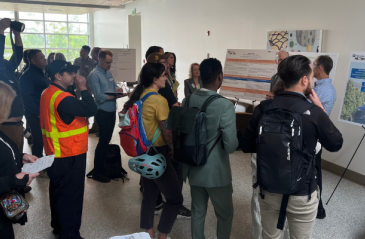
The information barriers holding back climate action and how to break them

The OMB has impact over mission performance, federal pay, benefits, and human capital policy
Share articleThe most successful projects have clearly defined metrics
Share articleSenior leadership engagement on data and an ability to make it used is vital
Share articleWe put our vision for government into practice through learning partner projects that align with our values and help reimagine government so that it works for everyone.
It's perhaps apt that Dustin Brown is based in the New Executive Office Building. Unlike its near neighbour, the Old Executive Office Building - stately, grandiose, ornate - Brown's digs, situated a few blocks away from the White House, appear far more straightforward.
Brown's surroundings chime nicely with his role as Deputy Associate Director for Performance and Personnel Management at the Office of Management and Budget (OMB), a role he has filled for eight years. Here, he juggles an eclectic smorgasbord of responsibilities, all designed to improve performance and delivery of government objectives. It's a role he is evidently enjoying.
While he reports to political appointees that are generally affiliated with a particular party/administration, he is a career member of the Senior Executive Service that does not change with administrations. “I am really happy and enjoy this job a lot because I get to have impact over a number of different areas,” he explains. “It involves not just mission performance of government agencies but also other things like federal pay, benefits, and human capital policy. We also help lead on some cross-agency issues such as infrastructure permitting reform, which aims to improve the permitting review process for things like bridges, dams and roads across a number of agencies. And we're also looking at improving the background investigation process.”
Asked whether multi-tasking is a pre-requisite for such a range of responsibilities, Brown prefers instead to steer the conversation towards the attributes of his OMB team. “The way I multi-task is quite simple,” he says. “I find really good people, recruit them in and then get out of the way. That's it.”
Brown's cross-agency role is a direct reflection of core mission of the OMB, which is to serve the President in implementing his vision across the Executive Branch. As the implementation and enforcement arm of presidential policy government-wide, OMB carries out its mission through a variety of processes, ranging from budget development and execution through to oversight of agency performance. Brown has a core OMB team of 10 people to help him in his efforts but then the numbers quickly increase.
“One step further removed are about 40 people who are in other offices but work closely with OMB to work across top priorities,” he says. “And then one further concentric circle out, there are about 750 people in agencies who our team meets with at least once a month through the working groups we lead. When I started this job, very little of this existed but over the past eight years we've taken on greater responsibility and have been able to grow our capacity. We're not finished - we're trying to recruit more people to not only work within agencies full time but who also wake up every day and work to drive the broader outcome of programmes.”
This is important because federal leaders have no shortage of distractions that can all too easily prevent them from focusing on results. “Policy, budget, legislation and communications are all huge drivers of leadership time and attention,” he admits. “While this is needed, we are interested in finding ways to carve out sufficient time to focus on implementation which can be a challenge - but we need to set the expectation that it is a core part of the job.” For example, early in this administration, he helped create a small team to run the Performance Improvement Council that has been able to focus on implementing the government-wide performance framework, building agency capacity, coordinating across agencies, and spreading promising practices.
Brown's cross-cutting role gives him a clear line of sight over the diverse functions of the federal government. While this ensures he has visibility of challenges, it also gives him a doorway into the many successes that are scattered across the landscape. This, in turn, helps him and his team piece together the reasons why programmes are successful - or not.
“The projects that I've seen work well have clearly defined metrics that enable you to track progress and adjust if necessary,” he reflects. “Putting in the hard work to establish what success looks like and how to measure it is really important.” He goes on to cite the importance of having strong leadership engagement on a consistent basis.
“I'm a huge fan of the standing meeting and getting a senior leader to zero in on a specific issue through to resolution - I've seen this make a big difference,” he reveals. “And there has to be a really good view across the entire delivery network. Many programmes are delivered through state and local government and non-profits - more so in our system of government than elsewhere - so you need to recognise this complexity and understand where your points of leverage are. This goes an awful long way towards your ability to have an impact. The system can be frustrating - there's no denying that - but time and again we've also seen extraordinary successes like HUD and VA's work on veterans' homelessness, which has fallen dramatically over the last few years.”
Brown, who maintains links in with the OECD, believes that there is much to learn from international counterparts, citing the work of the UK's Public Service Agreement framework and delivery units led by Sir Michael Barber and Ray Shostak, in particular, as having had a strong influence but it's not just overseas. He is also quick to praise the advances of colleagues in state and local government, some of which have come into Federal agencies with this data-driven approach.
“We wanted to incorporate the lessons from state and local government here in the US - ranging from the work done in Baltimore and Maryland, or some of the work in New York City,” he says. “In all of these examples, we have consistently seen the importance of senior leadership engagement and an ability to make it used and useful to them and their organisations. And this was really the system we wanted to put in place. Something that could endure over time.” He goes on to say that there is no shortage of examples from state and local jurisdictions.
“There are lots of mayors and governors who are moving forward on this agenda, as well as on other levels like county executives,” he says. “For example, there is even a DC-Maryland-Virginia Area Stat Consortium, which gives a sense of how strongly this has taken hold. When you go up to the Federal level there are inherent challenges as you get further away from the frontline, but I've got no doubt that things are moving in the right direction.”
Brown's positive disposition - “I'm definitely an optimist in life” - is clear but his belief that an increasing focus on delivery and impact is now taking root reflects more than just a glass half full mentality. “We have already issued guidance based on the updated GPRA Modernization Act requirements (2010) to agencies about when their strategic plans and priority goals are going to be due in the next administration,” he points out. “This guidance and timelines were published last July and it means that we can get to a point where there are certain routines that are expected.”
This type of routine, something that is somewhat taken for granted by colleagues working in the budget process, is what he aspires to achieve for those working in performance and delivery. “When I started out at OMB - I was working in the housing branch at the time - no one questioned the routine of the budget process,” he recalls.
“What we want to do is bring a similar discipline to the management and performance work. We want to get processes set to reach agreement on what the goals are, understand who owns them, how they are measured and how we report to the public on them. The foundations of this are now pretty well established - it's now up to us to keep building on this in the years to come.”











